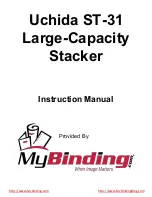
15
CA152 M152EN3
EVERY 50 HOURS OF OPERATION (Weekly)
1
2
1
1
Tires – tire pressure
Wheel nuts – tightening
Fig. 17 Wheels
1. Air valve
2. Wheel nut
Check the tire pressures using a pressure gauge.
If the tires are filled with fluid, the air valve (1) must be
in the “12 o’clock” position during pumping.
The relevant tire pressures are given under the heading
“Specifications”.
Check both tires.
When changing the tires it is important that
both of them have the same rolling radius. This
is necessary to ensure proper functioning of
the anti-slip in the rear axle.
Check the tightening torque of the wheel nuts (2) at 470
Nm (350 lbf.ft). Check both wheels and all the nuts.
(Applies only to new machine or recently fitted wheels.)
Check the safety manual that accompanies
the roller before filling the tires with air.
Never work under the roller with the engi-
ne running. Park on a level surface, chock
the wheels and press the parking brake
control.
Open the engine hood while the unit is running and look
at the sight glass (1) to make sure that no bubbles are
visible on the dryer filter.
Always push the parking brake knob.
The filter is located on the left side in the front of the
engine compartment. If bubbles are visible through the
sight glass, it is a sign that the level of refrigerant is too
low. If so, stop the unit. There is a risk of damage to the
unit if it is run with insufficient refrigerant.
Air conditioning (Optional)
– Inspection
Fig. 18 Drying filter
1. Sight glass
Fig. 19 Cab
1. Condenser element
In the event of noticeable deterioration of cooling capa-
city, clean the condenser element (1), which is located
at the rear of the cab roof. Also clean the cooling unit
inside the cab.
The system described in this manual is of the ACC
type (Automatic Climate Control)
Содержание CA152D
Страница 2: ...19 ILF015WO1...
















































